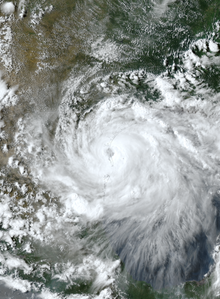
Back Huracán Hanna (2020) Spanish Ouragan Hanna (2020) French Furacão Hanna (2020) Portuguese Ханна (ураган, 2020) Russian Hurricane Hanna (2020) SIMPLE Ханна (ураган, 2020) Ukrainian 颶風漢娜 (2020年) Chinese
 Hanna at peak intensity making landfall in Texas on July 25 | |
| Meteorological history | |
|---|---|
| Formed | July 23, 2020 |
| Dissipated | July 26, 2020 |
| Category 1 hurricane | |
| 1-minute sustained (SSHWS/NWS) | |
| Highest winds | 90 mph (150 km/h) |
| Lowest pressure | 973 mbar (hPa); 28.73 inHg |
| Overall effects | |
| Fatalities | 9 |
| Damage | $1.2 billion (2020 USD) |
| Areas affected | Cuba, Hispaniola, Gulf Coast of the United States (mainly Texas), Mexico |
Part of the 2020 Atlantic hurricane season | |
Hurricane Hanna was the first of a record-tying six Atlantic hurricanes to make landfall in the United States in one year. The eighth named storm and first hurricane of the extremely active 2020 Atlantic hurricane season, Hanna developed from a tropical wave originating near Hispaniola. This disturbance dropped heavy rain upon parts of Hispaniola, Cuba, and Florida. The wave gradually became more organized and developed into a tropical depression in the central portion of the Gulf of Mexico. The depression strengthened into a tropical storm on July 24, setting a new record for the earliest eighth-named storm in the basin, getting its name 10 calendar days before the previous record holder, Tropical Storm Harvey of 2005. Hanna steadily intensified as it drifted toward Southern Texas, becoming the season's first hurricane early on July 25. It then began to quickly strengthen just before making landfall at 22:00 UTC later that day as a high-end Category 1 hurricane, with maximum sustained winds of 90 mph (140 km/h) and a minimum central pressure of 973 mbar (hPa; 28.73 inHg). Hanna weakened quickly as it moved inland and turned west-southwest, eventually dissipating over Mexico on July 26.
In Florida, the precursor to Hanna killed one person due to rip currents. Hanna's outer bands also caused rounds of thunderstorms across parts of the Northern Gulf Coast. Along the way, it dumped up to 18 inches (460 mm) of rain in isolated areas in Southern Texas and Mexico. The storm resulted in 50,000+ people losing power.[citation needed] Hurricane Hanna caused minor damage to well-built structures, serious damage to smaller structures, and downed powerlines. In Texas, where the storm made landfall, extensive property damage was reported in the Rio Grande Valley especially in Port Mansfield. The brunt of the damage was located south of Corpus Christi due to the eye taking a more southward path than originally forecast. Corpus Christi experienced storm surge flooding and tropical storm-force winds, while areas south of the city experienced hurricane-force sustained winds, and in Mexico, severe flooding caused by Hanna killed four people. Overall, Hurricane Hanna was estimated to have caused a total of at least $1.2 billion in damage.[1]
- ^ Adam.Smith@noaa.gov. "Billion-Dollar Weather and Climate Disasters: Events | National Centers for Environmental Information (NCEI)". www.ncdc.noaa.gov. Archived from the original on January 9, 2021. Retrieved January 8, 2021.
© MMXXIII Rich X Search. We shall prevail. All rights reserved. Rich X Search